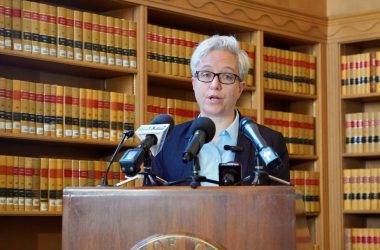Oregon lawmakers heard from state behavioral health officials and local addiction treatment providers during a four-hour meeting on Wednesday that confirmed that the drug epidemic is one of the most intractable problems Oregon faces and touches every part of the state.
Addiction treatment and the behavioral health system is complex. Bureaucratic barriers stand in the way of getting treatment to people when they need it. It’s hard to hire qualified providers, especially in remote rural areas, and programs need more money to hire and retain staff and build needed facilities. Many people have an easier time scoring fentanyl than they do finding treatment.
What lawmakers need now, said Sen. Kate Lieber, the Senate majority leader and co-chair of the new Joint Interim Committee on Addiction and Community Safety Response, is a clear direction on what they can do to get people into treatment.
“I’m putting a stake in the ground here for everyone who is listening. We need to get people off the streets now,” Lieber said. “We have run out of time to build the exact system we want. What can we do now to rapidly get people off the street in a safe way?”
The committee met for the first time Wednesday amid growing criticism of the state’s 2020 voter-approved drug decriminalization law, Measure 110. An epidemic of fentanyl overdoses and widespread frustration over public drug use has led legislative Republicans to call to repeal the law, while a coalition including Nike co-founder Phil Knight is pushing 2024 ballot measures to recriminalize possession of some drugs, mandate treatment and ban public use of drugs.
The behavioral health providers who spoke to the committee Wednesday broadly supported Measure 110.
“Measure 110 is the best thing that’s happened to providing treatment in Oregon,” said Tim Murphy, chief executive officer of Salem-based Bridgeway Recovery Services.
A second hearing on Nov. 6 will focus on law enforcement and the police response to addiction, and two more meetings before the Legislature convenes in February will help committee members draft specific recommendations for policy changes.
Lieber, D-Beaverton, is a former Multnomah County prosecutor who decided to remain in the Legislature instead of running for attorney general to focus on addiction and behavioral health issues. She told the Capital Chronicle after the meeting that she feels like the Legislature is playing Whac-a-Mole with behavioral health. As soon as lawmakers make progress on one aspect of the crisis, something else pops up.
Committee co-chair Rep. Jason Kropf, D-Bend and a former Deschutes County public defender and prosecutor, said he learned more about how the crisis manifests in different communities in the meeting. Drug abuse and behavioral health are problems throughout the state, but they look different in urban and rural areas. Legislators can help local communities be more innovative in finding solutions, he said.
Need for sobering centers
In Harney County, which spans more than 10,000 square miles, Burns-based Symmetry Care treats people in mental health and addiction crises. Sometimes, the provider goes days without receiving calls for help, Director Chris Siegner said.
He urged lawmakers to recognize that more money doesn’t always mean providers can bring in staff, especially in rural areas where it’s harder to recruit workers. And he asked them to think about how to get people into treatment when they aren’t competent to choose it for themselves.
“I don’t think anybody wants to criminalize drug use, but they also don’t want people who are unable to care for themselves to die in front of people,” he said.
Coos County Behavioral Health Director David Geels said his area needs a dedicated safe place where people who have overdosed or face mental health crises can go to take care of immediate needs and then work with his team and other providers on longer-term treatment.
“Some kind of sobering center or crisis stabilization center is crucial to do that,” he said. “We do not have that in Coos County. We don’t have it in Curry County.”
He said a center needs to be local and easily accessible – police aren’t going to drive an hour to drop someone off at a stabilization center.
Sen. David Brock Smith, R-Port Orford, represents Coos and Curry counties along with other areas of southwest Oregon. He’s not part of the committee but sat on the dais with committee members and asked questions. In a texted statement through a spokeswoman, Brock Smith said he was there because addiction was an important issue to his constituents.
“All three of my county boards of commissioners (Curry, Coos, Douglas) have passed resolutions urging the governor and/or Legislature to repeal Measure 110,” Brock Smith said. “My constituents are dying, my communities are frustrated and my public safety professionals do not have the tools they need to protect residents.”
Lieber said after the meeting that Brock Smith will not vote on anything in the committee because he’s not a member, but senators are allowed to join and ask questions.
‘Far more powerful’
The drug crisis in Oregon and across the country is driven by fentanyl, a cheap, highly addictive and often lethal drug. More than 930 Oregonians died from opioid overdoses in 2022 compared to 280 in 2019, according to Oregon Health Authority data.
Rick Treleaven, executive director of Bestcare Treatment, which provides addiction treatment in central Oregon, said he’s had more clients die in the last year than the last 25 years put together. He compared the fentanyl epidemic to the early AIDS epidemic, when public health officials struggled to keep people from risky behaviors and deaths were rampant.
“Our clients are coming in and they say ‘I’m scared of this drug,’ but they can’t stop,” Treleaven said. “In 40 years, I’ve never seen this.”
Some patients have reported recovering from multiple overdoses with naloxone, an overdose reversal drug, but each overdose puts stress on brains, similar to a concussion, and contributes to brain damage. Treleaven said he doesn’t expect to see long-term fentanyl addicts, because fentanyl, unlike heroin, isn’t a drug people can use long-term and expect to survive.
Joe Bazeghi, director of engagement at Recovery Works NW, said physicians started raising alarms around 2018 that the methods they used to help people detox from heroin and oxycodone weren’t working as well for fentanyl. The organization has provided medication-assisted treatment in Yamhill, Clackamas, Washington and Multnomah counties for the past 10 years and recently opened a 16-bed detox center in southeast Portland.
Fentanyl can be stored in fat cells, while other opioids are more easily excreted. That means people who appear to be stable and out of withdrawal can fall back into it, Bazeghi said.
“This stuff is far, far more powerful,” he said. “People come in with far, far more significant challenges.”
Kimberly Sue, an assistant professor of medicine at Yale School of Medicine and the former medical director of the National Harm Reduction Coalition, shared data from her work in New York State, where fentanyl has been the leading cause of overdose deaths since 2016.
Overdose deaths are paradoxically higher in areas that appear to have treatment available, she said. People who are homeless or incarcerated have the highest rates of overdose deaths.
“We are doing an abysmal job of getting people access to treatment that we know works,” she said.
Effective treatment includes recognizing that most people use more than just one substance, and may need treatment for alcohol or stimulants along with opioids, she said. Providers need to find ways to get addiction services to people outside of a traditional clinic, and drug users need access to medications like methadone and buprenorphine, she said.
“As long as it’s easier to get fentanyl than it is to get treatment for opioid use disorder, we will continue to see a rise in overdose deaths,” Sue said.
Oregon Capital Chronicle is part of States Newsroom, a network of news bureaus supported by grants and a coalition of donors as a 501c(3) public charity. Oregon Capital Chronicle maintains editorial independence. Contact [email protected]. Follow Oregon Capital Chronicle on Facebook and Twitter.




